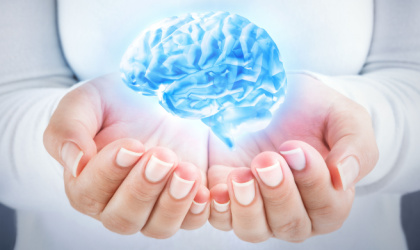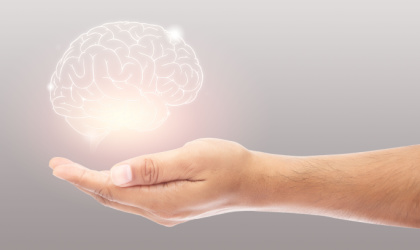
The brain is like a highly advanced central computer. But any good computer needs peripheral devices – a keyboard, microphone, and camera – to feed it information. And your brain is no different. The peripheral nervous system provides a gateway for your brain to receive information about the world around you. It’s a crucial part of the overall nervous system.
What is the peripheral nervous system?
Your nervous system comprises two main parts: the central nervous system, which contains your brain and spinal cord, and the peripheral nervous system, which encapsulates everything else, including the nerves that travel from your spinal cord and brain to your face and the rest of your body (1).
How the peripheral nervous system works
Your peripheral nervous system relays information from your senses to your brain. It carries signals that enable you to move your muscles (2). It also provides the brain with information to regulate important involuntary processes, like digestion and breathing.
Somatic vs autonomic nervous system
Your peripheral nervous system is divided into two main systems: autonomic and somatic.
Autonomic nervous system
The autonomic nervous system works automatically, controlling certain bodily processes without conscious effort, such as breathing rate, blood pressure, digestion, metabolism, urination, and sexual response (3).?
The autonomic nervous system is then further subdivided into sympathetic and parasympathetic.
-
The sympathetic nervous system governs the ‘fight or flight’ response in the body – when action is needed in the face of environmental threats, like fleeing from danger. It accelerates heartbeat, dilates pupils, and stimulates sweat production.
-
The parasympathetic nervous system does the opposite, regulating ‘rest and digest’ functions and conserving physical resources. Once a threat has passed, it reduces heart rate, slows breathing, and constricts pupils.
In other words, the sympathetic stimulates; and the parasympathetic inhibits. This antagonistic relationship helps to maintain balance in the body.
Somatic nervous system
Your somatic nervous system enables you to control and move muscles throughout your body (4). It also transmits information from your five senses – sight, sound, smell, touch, and taste – to your brain.? ?Your somatic nervous system involves functions you can consciously sense and do.
Peripheral nervous system support
There are plenty of ways to keep your peripheral nervous system healthy. Prioritising sleep, staying active, managing stress, and eating a balanced, wholefood diet are some tools to keep this delicate system in check. Avoiding smoking and drinking in moderation will also work wonders for your peripheral nervous system.
What vitamins support the peripheral nervous system?
Besides eating a nutritionally dense diet, you may also wish to include the following nutrients to provide targeted support for your peripheral nervous system.
B vitamins
The family of B vitamins is involved in many different biochemical processes, with vitamins B1, B3 (niacin), B6, B7 (biotin), and B12 contributing to the normal functioning of the nervous system. Find them: Green leafy vegetables.
To give your nervous system an extra helping hand, you might consider our high-strength B-complex, Neuro-B. This comprehensive formula is designed with healthy nerves in mind and contains relevant amounts of vitamin B1 for the nervous system, vitamin B6 (as PSP) for normal red blood cell formation, and B12 for normal neurological and psychological formation.
Iodine
Iodine is an important trace mineral needed in small quantities to support health. Crucially, iodine supports normal nervous system function. Find it: Prunes.
Magnesium
An essential mineral involved in over 300 biochemical processes; magnesium contributes to the normal functioning of the nervous system. Find it: Pumpkin seeds.
Vitamin C
Aside from immune health, vitamin C also plays an important role in supporting nervous system function. Find it: Goji berries.
Vitamin D3
Vitamin D3 is vital for good health. Some experts believe low levels may affect the nervous system (5). Find it: Eggs yolks.
Omega-3
The long-chain omega 3 fatty acids, EPA (eicosapentaenoic acid) and DHA (docosahexaenoic acid) are important to overall health. Perhaps most notably, DHA contributes to the maintenance of normal brain function.* Find it: Oily fish or plant-based microalgae.
* A beneficial effect is obtained with a daily intake of 250mg of DHA
Adaptogenic herbs
Adaptogenic herbs, like Ashwagandha, Siberian Ginseng, and Korean Ginseng, are often recommended to restore balance in the body (6).
Palmitoylethanolamide
PEA is an endocannabinoid-like compound found in almost every cell, tissue, and fluid in the body. Naturally produced when cells are damaged or threatened, PEA is a well-researched alternative to CBD. It’s a popular choice for wellbeing and nervous system function.
Theanine
The amino acid found in tea, theanine, is a useful addition to support the nervous system function and emotional health.
Turmeric
The active compound in turmeric, curcumin, has been celebrated for generations. Many people take it to support their overall health and wellbeing (7).
Want to learn more?
If you want to find out more about supporting your nervous system, please explore the rest of Nutrition Buzz. Alternatively, please get in touch with our team of expert Nutrition Advisors, who are on hand to provide free, confidential advice via email, phone, and Live Chat.**
**Subject to cookie consent
References:
-
Cherry, K. (2023) "What you should know about the peripheral nervous system." Verywell Mind. Available online: https://www.verywellmind.com/what-is-the-peripheral-nervous-system-2795465.
-
"Peripheral Nervous System (PNS)" (2023) Cleveland Clinic. Available online: https://my.clevelandclinic.org/health/body/23123-peripheral-nervous-system-pns.
-
"The peripheral nervous system" (2023) The Peripheral Nervous System. SEER Training. Available online: https://training.seer.cancer.gov/anatomy/nervous/organization/pns.html.
-
"Somatic nervous system" (2023) Cleveland Clinic. Available online: https://my.clevelandclinic.org/health/body/23291-somatic-nervous-system.
-
Wrzosek Mukaszkiewicz J, Wrzosek M, Jakubczyk A, Matsumoto H, Pitkiewicz P, Radziwo Zaleska M, Wojnar M, Nowicka G. (2013) "Vitamin D and the central nervous system." Pharmacol Rep. 65(2):271-8.
-
Panossian A, Wikman G. (2010) "Effects of Adaptogens on the Central Nervous System and the Molecular Mechanisms Associated with Their Stress-Protective Activity." Pharmaceuticals (Basel). 3(1):188-224.
-
Kulkarni SK, Dhir A. (2010) "An overview of curcumin in neurological disorders." Indian J Pharm Sci. 72(2):149-54.
Related Posts

Olivia
Olivia Salter has always been an avid health nut. After graduating from the University of Bristol, she began working for a nutritional consultancy where she discovered her passion for all things wellness-related. There, she executed much of the company’s content marketing strategy and found her niche in health writing, publishing articles in Women’s Health, Mind Body Green, Thrive and Psychologies.
View More






